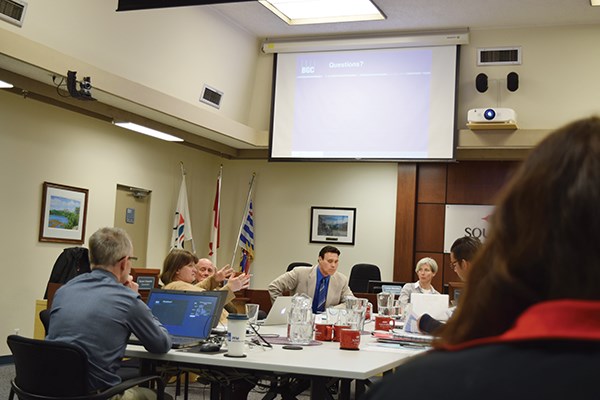A new report supports the idea of a massive debris flow barrier to protect lives and developments on the Cheekye Fan.
Matthias Jakob, a geoscientist with BCG Engineering, presented his firm’s preferred option to council Tuesday at the Community Development Standing Committee.
The Cheekye Fan is a large triangle-shaped deposit of gravel, sand and sediment. Such alluvial fans are common to mountainous regions. Previous studies have shown the risk to human life of a massive landslide in certain hazard areas on the fan are unacceptable, and some form of mitigation has to be done.
Jakob’s proposed debris flow barrier concept would protect against a 10,000-year return period event, he said, adding such a barrier would hold back 2.8 to 5.5 million cubic metres of debris. The proposed barrier would protect important infrastructure, including Highway 99, he said.
The exact design of the barrier is still to be worked out, Jakob said, but it would be placed on Crown land in the upper Cheekye canyon.
“The structure itself is thought to be made out of earth, largely,” Jakob said, “a well-designed pile of earth with a concrete outlet structure that would be able to withstand the forces that are associated with our design flows.”
Other options were considered, such as a debris flow barrier built lower down on the fan and a “debris flow highway” straight through the fan, but other options either were more complicated or did not protect First Nations land and funnelled debris into Squamish River, thereby transferring risk downstream, Jakob said.
The preferred, so-called “self-cleaning” dike would cost roughly $45 million, a cost Squamish Cornerstone Development, which is a partnership that includes Squamish’s Bethel Corporation, Matthews Southwest Development Company and the Squamish Nation, has offered to cover as part of its proposed 750-unit Brackendale housing development.
The yearly cost of the barrier to the district, as estimated by the consultants, would be about $15,000 per year, until a certain level of debris had accumulated.
The yearly maintenance could be funded by strata fees paid by residence of the proposed Cornerstone housing development of about $20 a month.
“That amount would accrue over time, and there is interest, of course,” Jakob said, noting it would add up to an estimated $180,000 a year, or $40 million in 70 years.
The chance of a major event happening before the 70-year benchmark is 0.07 per cent, according to Jakob.
In the off-chance a major event occurred prior to the accumulation of funds to do a cleanup, provincial and federal government grants along with insurance returns would likely be available to help cover the cost to the district, according to Jakob.
The developer commissioned the report.
After the presentation, Councillor Doug Race said the information made him more comfortable about moving the proposed Cornerstone housing development to the public hearing stage.
In February, council unanimously passed first reading of the zoning amendment bylaw and second reading of the official community plan – the early steps in the district’s development approval process.
“To give everybody in the community sort of a rough idea of what this mitigation looks like and the rough cost of it to me was a necessary step,” Race said on Tuesday. “For me, this was very helpful.”
A district-commissioned report by engineering consultants Kerr Wood Leidal on mitigation alternatives is slated.



